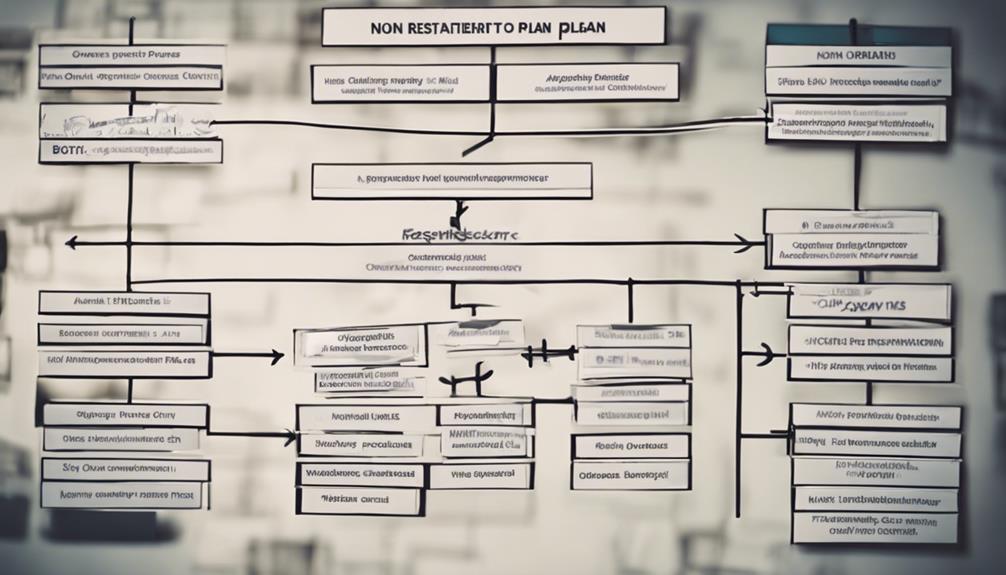When crafting business plans as a non-resident owner, ensuring a solid foundation is crucial.
From choosing the right business structure to understanding intricate legal and financial requirements, each step plays a vital role in your venture's success.
But what about the essential components like market analysis, competitive landscape assessment, and risk management strategies that could make or break your business's future?
Let's explore how these key criteria intertwine to shape the roadmap for your non-resident owner business plans.
Key Takeaways
- Comprehensive market analysis is essential for non-resident owners' business plans.
- Financial projections and risk management are crucial for investor confidence.
- Understanding industry trends and competitive landscapes aids in strategic decision-making.
- Regular updates based on market research ensure alignment with business goals.
Business Plan Overview
Crafting a comprehensive business plan is essential for non-resident owners to strategically outline their business goals, operational strategies, and financial projections. As non-resident entrepreneurs establishing an LLC, your business plan serves as a crucial tool for showcasing the potential profitability and sustainability of your venture. Within this plan, the section on financial projections holds particular importance as it demonstrates the expected financial outcomes based on your strategies and market analysis.
When outlining your financial projections, it's vital to provide detailed information on your revenue streams, cost structures, and projected profits. Investors and potential partners will closely examine these projections to assess the feasibility and growth potential of your business. Additionally, regularly updating your financial projections based on market trends and performance indicators will ensure that your business plan remains aligned with your strategic goals and current market conditions.
Market Analysis

When analyzing market trends, you must focus on understanding industry shifts, emerging opportunities, and potential threats.
Assessing your target market involves identifying customer needs, preferences, and behaviors to tailor your products or services effectively.
Evaluating the competitive landscape helps in positioning your business strategically and differentiating your offerings to stand out in the market.
Industry Trends Analysis
To effectively navigate the dynamic landscape of the marketplace, a comprehensive analysis of industry trends is imperative for non-resident owner business plans. Understanding market trends allows you to capitalize on opportunities and mitigate risks effectively. By monitoring competitor strategies, you can identify gaps in the market and refine your own approach. Here is a breakdown of key aspects to consider in your industry trends analysis:
| Market Analysis | Industry Trends | Competitor Strategies |
|---|---|---|
| Identify market size | Analyze technological advancements | Monitor competitor activities |
| Assess growth potential | Understand regulatory changes | Analyze product innovations |
| Define target demographics | Evaluate consumer behavior shifts | Identify market positioning |
Target Market Overview
For a comprehensive understanding of your target market, delve into the demographics, preferences, and trends shaping your business landscape. When conducting market analysis, consider the following key points:
- Analyze consumer behavior to anticipate their needs and preferences.
- Identify market segmentation to tailor your products/services effectively.
- Evaluate market size to assess the growth potential for your business.
- Study purchasing patterns to understand how customers interact with your offerings.
- Utilize market research tools to gather insights that guide strategic decision-making.
Competitive Landscape Assessment
To craft a successful business plan, it is crucial to conduct a comprehensive Competitive Landscape Assessment, focusing on market analysis for strategic advantage. When analyzing the competitive landscape, delve into market size, growth trends, and competitor strategies to identify lucrative opportunities. Evaluating competitor strengths and weaknesses alongside their market positioning provides valuable insights for developing effective business strategies. Conducting a SWOT analysis aids in assessing the competitive landscape thoroughly. Identify key market players, their market share, and customer preferences to tailor targeted marketing efforts. Utilize market research data to understand consumer behavior, market demands, and potential barriers to entry. By aligning your business with the competitive landscape, you can position yourself strategically for success.
| Aspect | Importance |
|---|---|
| Market Size & Growth Trends | High |
| Competitor Analysis | Critical |
| SWOT Analysis | Essential |
Competitive Landscape Assessment

Analyze the market share, growth rates, and competitive positioning of key industry players to gain valuable insights into the competitive landscape. Understanding the competitive environment is crucial for business owners to make informed decisions and develop effective strategies. By conducting a comprehensive competitive landscape assessment, you can identify opportunities for growth and potential threats to your business.
Here are key steps to consider:
- Identify direct and indirect competitors through thorough market research and SWOT analysis.
- Evaluate pricing strategies, product differentiation, and customer segments to determine competitive advantages.
- Assess barriers to entry, industry trends, and disruptive technologies that could impact your business.
- Use competitor analysis to refine your business strategies, enhance your offerings, and seize market opportunities.
- Continuously monitor and adapt to changes in the competitive landscape to stay ahead of the competition.
Financial Projections

When crafting your business plan's financial projections, focus on the accuracy of revenue forecasts, effective expense management strategies, and realistic cash flow projections.
These points are crucial for outlining the financial viability and growth potential of your business to stakeholders and potential investors.
Revenue Forecast Accuracy
Ensuring the accuracy of revenue forecasts in non-resident owner business plans is paramount for projecting future financial performance effectively.
- Analyzing market trends provides insights into potential revenue fluctuations.
- Utilizing reliable data sources like industry reports and financial databases enhances forecast precision.
- Considering competition dynamics helps in creating realistic revenue projections.
- Monitoring external factors such as economic conditions ensures adaptability in revenue forecasts.
- Regularly adjusting revenue projections based on performance indicators improves business planning for non-resident owners.
Expense Management Strategies
Implementing efficient expense management strategies is crucial for the financial projections of non-resident owner business plans. Tracking and analyzing expenses meticulously using budgeting tools can help identify cost-saving opportunities and optimize resource allocation. By utilizing these tools, you can streamline the expense management process and enhance financial visibility within your business plan.
Effective management of expenses contributes to accurate forecasting, adherence to budgets, and overall financial health. It's essential to monitor key expense categories like operating costs, marketing expenses, and overhead expenditures to ensure sustainable business growth. Embracing these strategies won't only improve your financial projections but also position your business for long-term success.
Cash Flow Projections
To strengthen your non-resident owner business plan, a meticulous focus on cash flow projections is essential for forecasting financial stability and operational sustainability. When crafting your financial projections, consider the following key points:
- Cash flow projections aid in estimating the flow of funds in and out of your business.
- Accurate financial projections help assess the viability and sustainability of your business ventures.
- Details on revenue, expenses, and anticipated cash reserves are typically included in these projections.
- Cash flow projections assist in identifying potential financial challenges and planning for contingencies to ensure business continuity.
- Utilize cash flow projections to make informed decisions, secure funding, and showcase financial health to stakeholders.
Risk Management Strategies

Effective risk management is paramount for safeguarding non-resident owner business interests. To protect your business assets and financial stability, implementing insurance coverage is crucial. This helps mitigate potential financial risks that may arise from various unforeseen events. Developing contingency plans for situations like natural disasters or economic downturns is essential to ensure business continuity. Regular risk assessments are vital for identifying vulnerabilities and proactively addressing them before they become significant threats. Additionally, establishing robust cybersecurity measures is necessary to safeguard sensitive data and prevent cyber threats that could compromise your operations.
To provide a clearer overview, consider the following risk management strategies:
| Risk Management Strategies | Description | Importance |
|---|---|---|
| Insurance Coverage | Protects business assets and operations | High |
| Contingency Plans | Prepares for unforeseen events | Critical |
| Cybersecurity Measures | Safeguards sensitive data and prevents cyber threats | Essential |
Marketing and Sales Plan

Developing a comprehensive marketing and sales strategy is essential for non-resident owner businesses to effectively reach their target audiences and drive revenue. To ensure success in this aspect of your business plan, consider the following key criteria:
- Utilize Digital Marketing: Leverage channels such as social media, email marketing, and SEO to enhance brand visibility in the digital landscape.
- Implement Sales Tactics: Boost revenue generation by employing tactics like promotions, discounts, and strategic partnerships to incentivize sales.
- Analyze Market Trends: Stay ahead of the competition by closely monitoring market trends and consumer behavior to tailor your marketing and sales efforts for maximum impact.
- Monitor KPIs: Evaluate the effectiveness of your marketing and sales initiatives by regularly tracking key performance indicators and making data-driven decisions to optimize performance.
- Adopt a Holistic Business Strategy: Integrate your marketing and sales plan seamlessly into your overall business strategy to ensure alignment and maximize results.
Operational Plan

Crafting a detailed operational plan is crucial for non-resident owner businesses to streamline their processes and achieve their desired objectives efficiently. An operational plan outlines the specific processes and activities required to achieve business goals. It includes details on resources, timelines, responsibilities, and key performance indicators. The operational plan acts as a roadmap for day-to-day operations and helps ensure efficient execution. By addressing key operational aspects such as production, marketing, sales, and customer service, a well-developed operational plan enhances organizational efficiency and supports strategic decision-making.
| Aspect | Details |
|---|---|
| Processes | Specific activities to achieve goals |
| Resources | Allocation and utilization |
| Timelines | Set deadlines for tasks |
| Responsibilities | Assigned roles for execution |
| KPIs | Metrics to measure success |
Frequently Asked Questions
Can a Non-Resident Own a Business in the Us?
Yes, as a non-resident, you can own a business in the U.S. Legal requirements, visa options, and investment opportunities are crucial considerations.
Ensure compliance with U.S. tax laws and regulations. Explore visa categories like E-2 Investor Visa for treaty countries. Capitalize on the diverse market and venture capitalist landscape.
Seek professional guidance to navigate complexities and seize growth opportunities in the U.S. business environment.
Which State Is Best for an LLC for a Non-Resident?
When choosing a state for your non-resident LLC, consider key factors like state comparisons, legal requirements, and tax implications. Delaware offers advantages for future C-corp conversion, while Wyoming attracts with its cost-effective setup.
Research thoroughly as each state has specific requirements and costs. Make an informed decision that aligns with your business goals and budget. Your choice will impact your LLC's success and growth potential.
What Are the Taxes for a Non-Resident Owner of a US Llc?
When you're a non-resident owner of a US LLC, tax implications can vary based on your business's income and where it operates. Understanding tax residency and filing requirements is crucial to avoid double taxation.
Exploring tax treaties between the US and your home country is wise. Consulting with tax professionals experienced in non-resident taxation can help you navigate the complexities of US tax laws for LLC owners.
What Business Can a Foreigner Do in Usa?
You can explore a world of possibilities as a foreigner looking to start a business in the USA.
From investing in diverse sectors like technology, healthcare, and hospitality, to fulfilling legal requirements and conducting thorough market research, the opportunities are endless.
Dive into the realm of investment opportunities, navigate legal requirements, and delve deep into market research to carve out your path in the US business landscape.
Conclusion
As a non-resident owner, you have successfully navigated the complexities of starting a business in the U.S. Key criteria such as selecting the right business structure and understanding investment requirements are crucial for your venture's success.
Did you know that non-U.S. residents invested over $9.2 billion through the EB-5 Immigrant Investor Program in 2020? By carefully planning and executing your business plan, you're on track to achieve your goals and thrive in the competitive market.